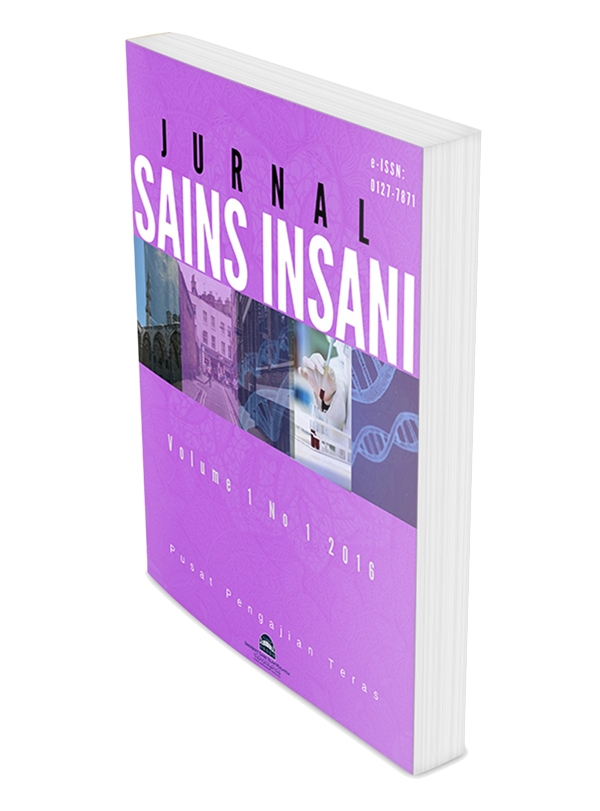Motivasi Saintis Muslim Dalam Perkembangan Ilmu STEM: Sorotan Literatur Bersistematik
Motivation Of Muslim Scientists In The Development Of STEM Knowledge: A Systematic Literature Review
DOI:
https://doi.org/10.33102/sainsinsani.vol10no1.706Keywords:
Motivasi, Saintis, Muslim, STEMAbstract
Saintis Muslim di zaman silam dan masa kini memainkan peranan penting dalam perkembangan ilmu sains, teknologi, kejuruteraan dan matematik (STEM). Sumbangan dan pencapaian mereka telah direkod dalam pelbagai dokumen seperti manuskrip, buku, dan artikel jurnal. Di sebalik itu, aspek psikologi terutamanya motivasi menjadi ruang yang sangat menarik untuk diteliti dengan lebih lanjut. Oleh itu, kajian ini bertujuan untuk mengungkap faktor pendorong yang melatari minat dan usaha para saintis Muslim dalam mengembangkan ilmu STEM di era masing-masing. Dengan menggunakan model PRISMA, terdapat enam (6) buah artikel penyelidikan yang diterbitkan oleh jurnal berwasit antara tahun 2014-2024 telah dirangkumkan berdasarkan kriteria yang ditetapkan. Hasil analisis literatur secara sistematik mendapati bahawa para saintis Muslim berasal dari pelbagai negara dan memiliki latar belakang pendidikan yang berbeza antara satu sama lain. Daripada aspek motivasi, faktor intrinsik dan ekstrinsik seperti sikap ingin tahu dan minat yang tinggi, pemikiran kritikal dalam penyelesaian masalah, pengiktirafan akademik, kefahaman agama Islam, dan proses perkembangan diri telah mendorong para saintis Muslim untuk menguasai lebih daripada satu bidang STEM dan memberi sumbangan yang signifikan dalam bidang masing-masing. Justeru, kedua-dua bentuk motivasi ini perlu digarap dalam diri generasi seterusnya agar minat dan usaha mereka dalam bidang STEM memberi manfaat dan kebaikan kepada masyarakat dan negara.
Downloads
References
Deci, E. L., & Ryan, R. M. (2010). Intrinsic motivation. The Corsini Encyclopedia of Psychology, 1-2 https://doi.org/10.1002/9780470479216.corpsy0467
Gamini, A. M. (2021). A Critique of Darwin’s The Descent of Man by a Muslim Scholar in 1912: Muḥammad-Riḍā Iṣfahānī's Examination of the Anatomical and Embryological Similarities Between Human and Other Animals. Journal of the History of Biology, 54(3), 485-511. https://doi.org/10.1007/s10739-021-09641-w
Halim, L., Abd Rahman, N., Zamri, R., & Mohtar, L. (2018). The roles of parents in cultivating children's interest towards science learning and careers. Kasetsart Journal of Social Sciences, 39(2), 190-196.
Hashemimehr, M. (2023). The Most Important Medical Theories and Works of Abu Sahl Masihi, an Iranian Scientist during the Golden Civilization of Islam. Jurnal El Tarikh: Journal of History, Culture and Islamic Civilization, 4(2), 64-71. http://dx.doi.org/10.24042/jhcc.v4i2.17946
Kamrujjaman, M. (2022). Professor Jamal Nazrul Islam: The Scientist Wandering in Theoretical Science, Astronomy, and Cosmology. GANIT: Journal of Bangladesh Mathematical Society, 42(1), 001–009. https://doi.org/10.3329/ganit.v42i1.60996
Kennedy, J., Lyons, T., & Quinn, F. (2014). The continuing decline of science and mathematics enrolments in Australian high schools. Teaching Science, 60(2), 34.
Lin-Siegler, X., Ahn, J. N., Chen, J., Fang, F. F. A., & Luna-Lucero, M. (2016). Even Einstein struggled: Effects of learning about gre at scientists’ struggles on high school students’ motivation to learn science. Journal of Educational Psychology, 108(3), 314.
Mohamad Ayub, A. (2018). Kesedaran terhad mengenai pendidikan STEM di Malaysia. Prosiding Seminar Kebangsaan Majlis Dekan Pendidikan Universiti Awam 2018 Penyunting: Rahimah Embong, Hanif Md Lateh @ Junid, Mustafa Che Omar, Mohamad Zaidin Mohamad & Abdul Hakim Abdullah.
Mohd Shahali, E., Halim, L., Sattar Rasul, M., Osman, K., & Mohamad Arsad, N. (2018). Students’ interest towards STEM: a longitudinal study. Research in Science & Technological Education, 1–19.
Mohd. Khalid, H., Zainatul Nadra Zainol, N., Ahmad, S., Hisyam Mohd Abdul Rahim, M., & Shakor Borham, A. (2018). Islamic Scholar and Regional Development: Analyze on Sinanâ Contribution in Civil Engineering. International Journal of Engineering & Technology, 7(3.25), 508-511. https://doi.org/10.14419/ijet.v7i3.25.17741
Morgenroth, T., Ryan, M. K., & Peters, K. (2015). The motivational theory of role modelling: How role models influence role aspirants’ goals. Review of General Psychology, 19(4), 465-483.
O'Hara, R.E. (2018). The Power of Stories to Teach and Motivate STEM Students. https://www.psychologytoday.com/us/blog/nudging-ahead/201806/the-power-stories-teach-and-motivate-stem-students
Phang, F. A., Abu, M. S., Ali, M. B., & Salleh, S. (2014). Faktor penyumbang kepada kemerosotan penyertaan pelajar dalam aliran sains: satu analisis sorotan tesis. Sains Humanika, 2(4).
Rahim, F., Iksan, Z., Othman, O., Wan Abdullah, W. N., sheikh abdullah, S., Arsad, N., Halim, L. (2015). Pemerkasaan Ulul Albab melalui modul STEM bersepadu STEMind. Online Journal of Islamic Education, 3, 1–12.
Rashid, S. A. (2015). The role of religious sociocultural context in promoting positive attitude towards science among Malaysian students. International Journal on New Trends in Education and Their Implications.
Royyani, M. A., Kibtyah, M., Adeni, A., Rofiuddin, A. A., Machzumy, M., & Kholis, N. (2023). Religious Dialogue and Astronomy from the Perspective of Indonesian Muslim Scholars. Samarah: Jurnal Hukum Keluarga dan Hukum Islam, 7(1), 261-280.
Saputra, H. (2023). Al-Khawarizmi: A Muslim Scientist Who Discovered Algorithms And Their Influence In The Development Of Modern Computation. Journal of Multidisciplinary Science, 2(2), 84–93. https://doi.org/10.58330/prevenire.v2i2.186
Sneideman, J. M (2013). Engaging Children in STEM Education Early! Feature Story. Natural Start Alliance and NAAEE. Retrieved from http://naturalstart.org/feature-stories/engaging-children-stemeducationearly
Sorge, C., Newsom, H. E., & Hagerty, J. J. (2000). Fun is Not Enough: Attitudes of Hispanic Middle School Students toward Science and Scientists. Hispanic Journal of Behavioural Sciences, 22(3), 332–345.
Wigfield, A., & Cambria, J. (2010). Achievement motivation. The Corsini Encyclopedia of Psychology, 1-2.
Downloads
Published
How to Cite
Issue
Section
License
Copyright (c) 2025 Sarifah Nurhanum Syed Sahuri (Author)

This work is licensed under a Creative Commons Attribution 4.0 International License.
1. Author holds the copyright of the article.
2. Jurnal Sains Insani owns the rights to publish the article. The writer may request permission to republish the article from the editor.
3. Jurnal Sains Insani follows the APA (American Psychological Association) style for all in-text citation and list of bibliographies.










